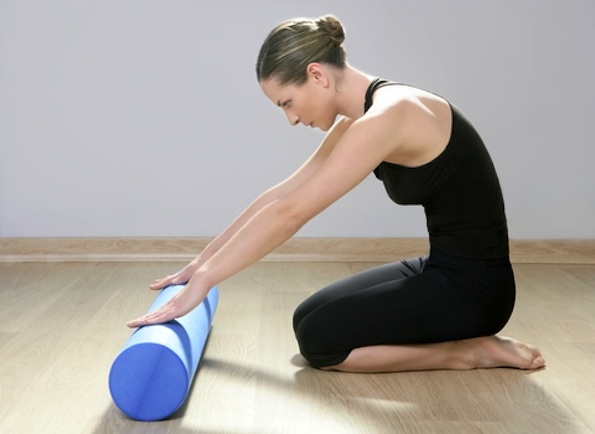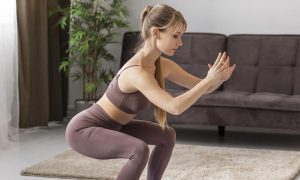By Laura Di Orio.
You may have seen some dancers with a large, cylindrical device poking out of their dance bag, or others laying on what looks like a foam log before class. And you may have asked yourself, “What is that? And what are they doing?”
That device is a foam roller, and what it’s used for is foam rolling, or self-myofascial release (SMR). This technique can be used by athletes and dancers to roll out muscle tightness and to relieve knots in the connective tissue, which cover your muscle and bones and support the body’s major structures.
Here, Marissa Joseph, a personal trainer based in New York City and founder of Working Lines: Cross-Training for Professional Dancers (www.workinglines.org), speaks to Dance Informa about the fundamentals of foam rolling and how it is beneficial, specifically for dancers.
How Foam Rolling Works
The kinks, or adhesions, in the body’s connective tissue are a result from under-use, over-use, microtrauma and so forth. Dancers do continuous and repetitive movements, which can, over time, tighten up the body’s muscles and produce those kinks in the tissue.
“SMR works primarily on a neuromuscular level,” Joseph explains. “Even more so than other athletes who undergo cross-training regimens to keep a balanced body, dancers often have over-worked muscles due to the extremely repetitive nature of the technique. These overworked muscles and fascia become tight because the nerves that connect them to the brain begin to fire overtime and create tension. The connective tissue of the muscles then knots up, pulls on the tendon, which in turn pulls a little extra hard on bones, and voilà! You have created a muscle imbalance and are now at a greater risk of injury. However, continued practice of SMR will allow your muscles to work at their best and therefore prevent injury.”
For instance, “when the muscles of the back become tight, they can inhibit your ability to go into back extension and rotation, which in turn may block some important movements as your cambré and arabesque,” Joseph explains. “When muscles in the lower body become tight, they may pull on the knee and make plié uncomfortable or inhibit your ability to fully flex your foot, extend your leg or execute a flawless rond de jambe.”

Marissa Joseph, a personal trainer based in NYC, strongly encourages dancers to foam roll. Photo by Breegan Kearney.
How to Foam Roll
To foam roll, you can apply your weight on top of the roller and roll back and forth along the length of the muscle. Joseph recommends repeating this slowly about 10 times on each muscle. If you find an extra tight, tender spot, you can rest on the spot for a few seconds, rocking back and forth to work out the kinks.
Joseph says it is safe to foam roll any muscle of the body, but she warns that you should NOT roll over your joints – knee cap and hip joint, for example. Also, she advises to foam roll any given muscle for only up to one minute.
As for where on your body to foam roll when there is a specific ache, pain or tightness, it may be less obvious than you think. If you have a pain in your knee, for example, it could stem from tightness in your quadriceps, IT band, gluteals or abductors.
So, Joseph recommends, “If you are experiencing discomfort at a joint, I would suggest rolling out the full length of the muscles surrounding the joint. If what you are feeling is a tight sensation in a muscle, I would say the best bet is to foam roll the muscle itself and the surrounding muscles.”
When to Foam Roll
“There is almost no bad time to roll,” Joseph says. “If you had to pick one time for SMR, however, I would tell you to roll out before class or rehearsal. SMR does a good job of promoting blood flow to the muscles you roll and irons out some of the kinks before a strenuous day’s work. Both effects are a vital part of preventing injury.”
Joseph adds that you should avoid SMR when your muscles are extremely sore. “Your muscles need time to heal when they are super sore, and foam rolling won’t help,” she says. “If your muscles are just a little sore, though, SMR is okay.”
Foam Rolling Works!
Joseph says she has had multiple success stories with clients who are dedicated with their foam rollers. Some have alleviated back, knee and foot pain.
“My favorite story,” she adds, “is of my 68-year-old male client who has always been an avid exerciser. With foam rolling alone – no stretching – he successfully touched his toes for the first time in 20 years and then ran around the gym to show everyone what he could do.”
Joseph says that foam rolling is imperative for athletes. And dancers are athletes! “It’s totally essential for health and should be done every day as part of your daily routine,” she says. “Even if you don’t feel you are particularly tight, I still recommend rolling. I couldn’t stress its importance enough.”
For more information on foam rolling, check out Joseph’s blog, www.workinglines.org, where you can also find loads of other pertinent information on cross-training and keeping a healthy, in-tune dancer body.
Photo (top): © Lunamarina | Dreamstime.com
















Pingback: I’m Sore! Now What? - How Dancers Should Handle Soreness | Dance Informa Magazine